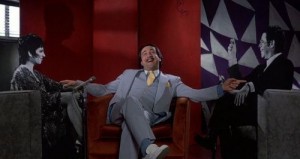Jul 172015

Mom!
No fuss, no muss: it’s not yet Saturday night, but desperate times call for desperate measures, as your host, Mr. Moderator, struggles to get back in the flow of revitalizing the music discussion blog he founded with a core group of contributors many moons ago.
RTH Saturday Night Shut-In 142
[Note: You can add Saturday Night Shut-In episodes to your digital library by subscribing to the Rock Town Hall feed.]


Thank you
I second that.
Thanks for compiling this, Mod. I always enjoy listening and have found considerable satisfaction in listening to music I’m not typically acquainted with. It’s one of the things I like best about this site: when we share music that other people may not know as well. On this show, I particularly enjoyed the Mamas and the Papas, the Patti Labelle, and the Nick Lowe. The early electronica piece was also interesting – I forget who that was, though.
Mr. Royale and I did a big Amoeba Music shop yesterday…just think, I could regale you with some OMD deep cutz. (Disclaimer, we also bought some new music and other tracks that are more RTH-worthy…)
That long drone track was by Heldon, a French band, I believe, from the mid-’70s.
Pretty avant-garde.
I really liked that Steve Howe track. I can share a little story about him. A few years ago, I was asked to organize a “tribute” to the then-recently-departed Walter Sear at an audio conference. Walter was the owner of the longest-running recording studio in NYC, still in operation. It is known as a bastion of old-school, analog, tube audio and Walter’s joke was “it wasn’t vintage when I bought it.”
Walter had a fascinating journey – he was a brilliant mind, creative and discerning. But he was also a wheeler-dealer who re-made his image in later days as a sage of high quality sound. Quickly, he was a tuba player, then tuba designer and seller. No matter the venture, he was always a businessman at heart.
It was at a music trade show that he met a young Bob Moog, whom he took under his wing and helped him to get his company started. With synths in hand, Sear built an electronic music studio which evolved into the studio that exists today, still with a massive Moog modular in one room.
At one point, however, Sear broke off his relationship with Moog and began selling the Electrocomp synth. Sear then used this synth as the basis for attempting to build a guitar controller (Sear had a partner in this venture, Russ Hamm), one of which was sold to Steve Howe. While researching for my presentation, I sent an email to Howe’s management with some questions and lo and behold, he responded!
Howe was partially convinced to buy the guitar because he was told that Frank Zappa was considering one. But Zappa didn’t buy one, as apparently he said he “wouldn’t pay more than $500 for any guitar.”
Howe tried out the guitar, which was monophonic but possibly to become polyphonic in an upgrade. Many promises were made regarding the potential of the instrument. He paid $12500 for an Ampeg guitar retrofitted with some kind of pickup and “a box on wheels with a sloping front with various knobs and switches on it. It was nothing but trouble.” The unit went back and forth between NY and London a few times, in hopes of fixing it up to become actually useful. Sadly, the unit got misplaced in a NY airport, lost, never seen again and not insured. All that trouble, money, all those promises, now worth nothing.
Here is a photo of the instrument:
http://www.guitarinsite.nl/Effect/WalterSear.jpg
Awesome tale, cher! The photo is not showing for me. Is anyone seeing it when they click on the link?
I’m not able to see the photo either.
I really enjoyed this edition of “shut in,” mr. Mod.
THANKS!!!!
But speaking of classic rockers using guitar / synth hybrids, check out this picture of Jimmy Page:
http://www.rolandus.com/blog/wp-content/uploads/2013/07/jimmy-page-roland-ad.jpg
Ha! What was the deal with that bar? It always made me think of those saws used to cut down tree branches. Was there a use for it, or was it simply a way of distinguishing the synth guitar from the traditional “ax”?
If you look closely, it says “Stanley” on it.
YES! [in the voice of Marv Albert]
That’s weird, the link works for me…
I believe that bar was a ‘stabilizer’ that was intended reduce stray overtones, the idea being that you wanted to signal sent to the synthesizer to be a note of a certain pitch without anything to throw off the pitch-to-voltage converter. It was an evolutionary dead-end, I guess.
That Kenny Gamble track was groovy.